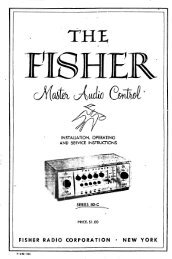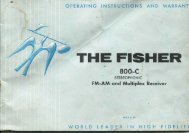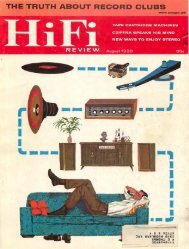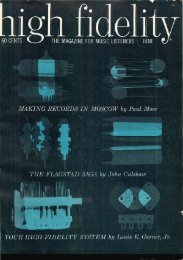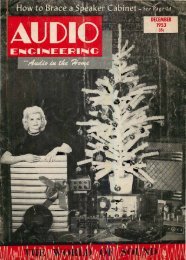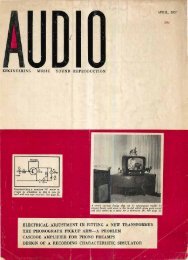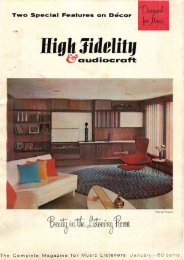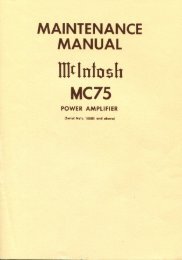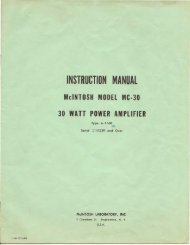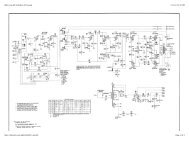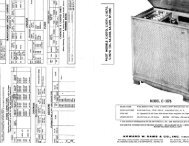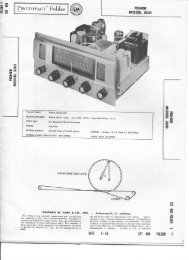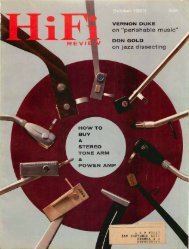~flr'6,r"®
Hifi Stereo Review â July 1958 - Vintage Vacuum Audio
Hifi Stereo Review â July 1958 - Vintage Vacuum Audio
- No tags were found...
You also want an ePaper? Increase the reach of your titles
YUMPU automatically turns print PDFs into web optimized ePapers that Google loves.
It takes a small diaphragm, very quick and light on<br />
its feet, to move forward, stop, move back, stop, and<br />
repeat this 15,000 times per second. Although a small,<br />
light cone can do this, it unfortunately cannot get hold<br />
of nearly enough air to produce those big waves, 20<br />
and 30 feet long, that represent the low bass notes.<br />
Conversely, the big cone that can turn out the long,<br />
slow-vibration waves cannot keep up with the fast<br />
footwork necessary at the top of the scale.<br />
That is not all. The cone, as it goes about its job of<br />
beating the air in rhythm with the electrical frequencies,<br />
must move back and forth a short distance. How<br />
far does it have to move? Take a cone four inches in<br />
diameter and set it to producing a 2,000 cycle note.<br />
To put out a steady one watt of sound, which is much,<br />
much louder than comfortable living room volume, the<br />
cone must move back and forth about 25 ten-thousandths<br />
of an inch. To allow for this motion in the<br />
flexible mounting that holds the cone to the speaker<br />
frame presents no problem in design or construction.<br />
The cone can be made to feel "free" over this short<br />
it may be wise to go even further and divide the job<br />
into three parts: high, middle and low.<br />
vVith the acquisition of a separate tweeter and woofer,<br />
a new factor arises. If they are connected directly<br />
to the amplifier, omigosh! The big bass notes will certainly<br />
give the tweeter a monumental case of indigestion,<br />
one from which it may never recover. The<br />
chances are excellent that the cone will be torn from<br />
its supports or the coils burned out by the surging currents<br />
of the big slow waves.<br />
The highs also would be flowing through both speakers<br />
and the least effect of this would be that they would<br />
be wasted on the woofer. However, although the heavy<br />
diaphragm and coil are massively disdainful of these<br />
tiny impulses and refuse to be pushed around much by<br />
them, they do not escape completely unscathed. The<br />
big cone has a tendency to ripple and b end when very<br />
fast impulses are applied instead of moving b ack and<br />
forth all in one piece. This bending is called "breakup"<br />
by the engineers. It is a prime source of coarse, nasty<br />
sound in loudspeakers. So what the highs do achieve<br />
when they are routed tlu-ough a woofer is mostly distortion,<br />
and that we can do without.<br />
The course b ecomes clear. The lows must be kept<br />
out of the tweeter and the highs out of the woofer. The<br />
gadget that does this is the "crossover network" This<br />
electronic traffic-cop is a collection of coils and capacitors<br />
which separates the big waves from the little ones.<br />
It directs the big ones to the woofer and the little ones<br />
to the tweeter.<br />
Choose the Crossover Frequency Carefully<br />
These two speakers illustrate the differences<br />
in cone structure and area discussed in the<br />
text. The speakers are a twelve-inch woofer<br />
(Cletron Cathedral Series, 30-5000 cycles) and<br />
a four-inch tweeter (also Cletron Cathedral<br />
Series, 1800-18,500 cycles).<br />
distance and thus avoid the distortion that would result<br />
if the mounting were stiff and held the cone tightly.<br />
Now suppose the same cone is required to put out<br />
one watt at 100 cycles. It would have to move % of an<br />
inch in each direction, 300 times the distance it had to<br />
travel at 2,000 cycles. This is too great a distance to<br />
allow for with so small a cone. On the other hand, if<br />
t11e cone is 16 inches across, one watt at 100 cycles<br />
would require only 5 one-hundredths of an inch of<br />
motion.<br />
Why Two- and Three-Way Speaker Systems<br />
It is obvious that the problems created by these dis- .<br />
tances and these speeds are more readily solved b y the<br />
use of a large cone ("woofer") for the low notes and a<br />
small cone ("tweeter") fm the high notes. A single<br />
speaker of careful design can do a competent, wellbalanced<br />
musical job if the listener is satisfied with<br />
something less than the utmost in complete frequency<br />
range coverage at good volume. But if the listener demands<br />
highs that are high and lows that are really low,<br />
and wants to hear them sound forth realistically, the<br />
speaker system must consist of at least two units, and<br />
42<br />
The crossover network is connected to the amplifier<br />
and the two speakers are connected to the crossover<br />
network In a speaker system that is designed as a<br />
unit, the proper crossover network is usually built in.<br />
If, however, woofer and tweeter are procured separately,<br />
then a crossover network must be added to work in<br />
conjunction with them. It is extremely important to<br />
get one that will perform properly with the speakers<br />
that are to be used. Preferably, the recommendation<br />
of the speaker manufacturer should be obtained so<br />
there will be no error made in the selection of the crossover<br />
network A network that does not match the<br />
speakers can cause much aural misery.<br />
Networks are rated in terms of a "crossover frequency."<br />
This is the arbitrary point where the woofer and<br />
the tweeter put out about the same volume level. If<br />
you go higher in frequency the tweeter produces all of<br />
the sound. If you go lower, the network prevents the<br />
electrical waves getting into the tweeter and feeds them<br />
only to the woofer. Crossover networks are especially<br />
designed to prevent a "sonic hole" where no power is<br />
being fed either speaker. Where to put this crossover<br />
frequency, whether relatively high or low in the scale,<br />
is the subject of much debate among audio hotbloods.<br />
And if the system consists of more than two speakers,<br />
the problem becomes more complicated and the debate<br />
correspondingly more intense.<br />
Proper design of a cross,over network requires knowledge<br />
and skill. Good engineering will feed that speaker<br />
right and avoid any semblance of an aural stomachache.<br />
-END<br />
HIFI & MUSIC REVIEW




